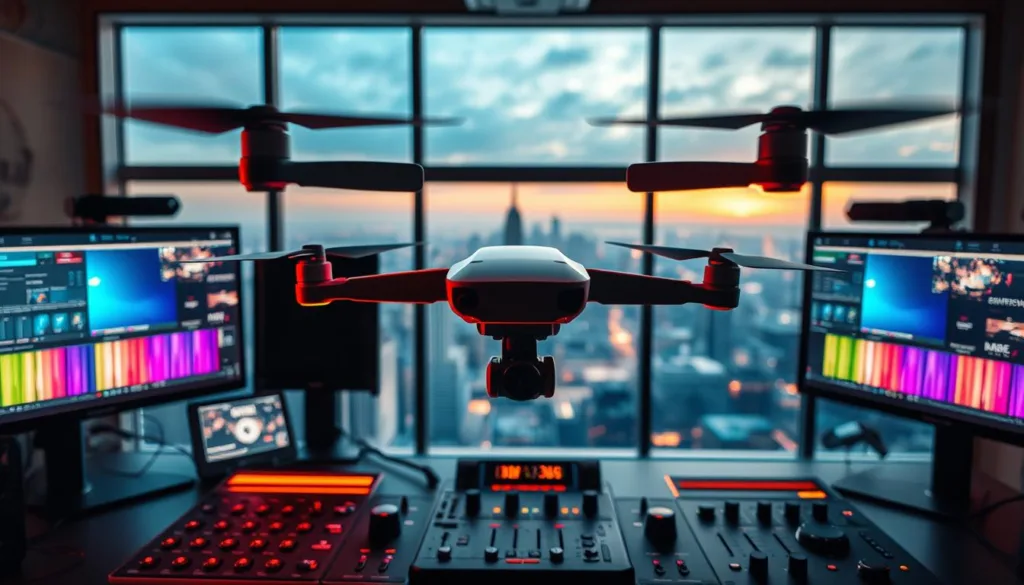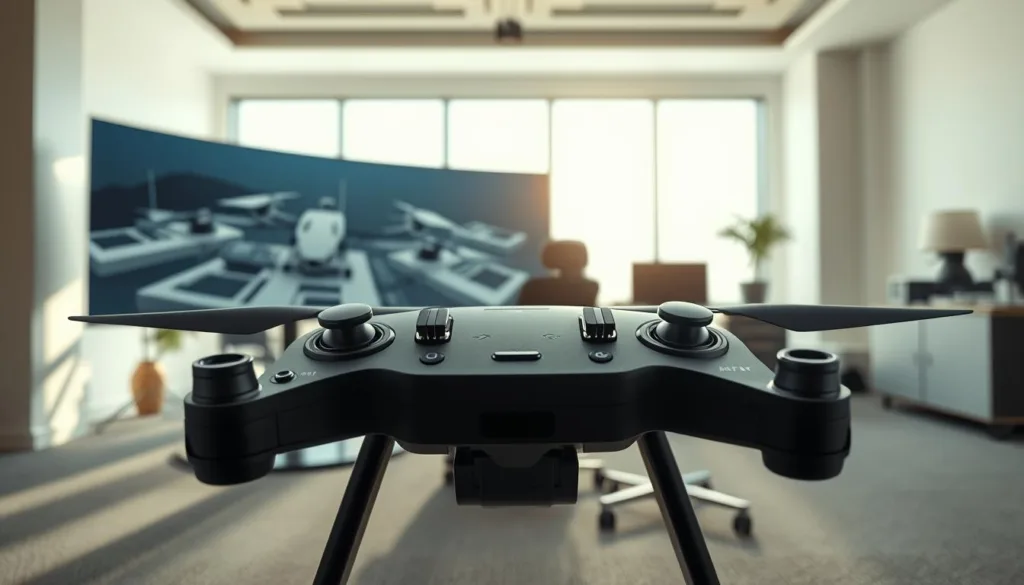Stepping into aerial photography or professional piloting? Modern technology offers a risk-free way to sharpen your skills. Specialized training platforms create lifelike environments where users can practice maneuvers and master equipment controls. These tools replicate real-world physics, weather patterns, and equipment responses with startling accuracy.
Many professionals now consider simulation practice essential for building muscle memory. The right controller mimics actual hardware, providing tactile feedback through every joystick movement and button press. This approach helps users avoid costly mistakes while learning complex operations like color correction or thermal data interpretation.
Advanced software solutions integrate features supporting creative workflows. Some platforms include tools for enhancing visual outputs through specialized profiles. Others offer diagnostic capabilities for analyzing technical performance metrics.
Key Takeaways
- Simulation training reduces equipment damage risks during skill development
- Realistic controller feedback bridges virtual practice and actual operations
- Weather scenario replication prepares users for challenging environments
- Specialized tools support color enhancement and technical diagnostics
- Consistent practice builds crucial decision-making abilities
- Cross-platform compatibility allows seamless transition between devices
From hobbyists to enterprise users, these systems adapt to various skill levels. Some configurations even support third-party accessories for specialized tasks. Whether refining camera adjustments or mastering emergency protocols, virtual training accelerates proficiency through repetition.
Getting Started with dji rc n1 flight simulator
Mastering professional-grade equipment starts with proper setup and configuration. The journey begins the moment you lift the controller from its packaging, revealing ergonomic design features built for precision handling.
Unboxing and Installation
Your training tool arrives ready for action. The sturdy construction and intuitive button layout become apparent immediately. Connect to your computer using the included USB-C cable, then visit the manufacturer’s website for essential software downloads.
Choose between consumer and enterprise versions of the configuration tool based on your device model. One user manual states:
“Proper driver installation forms the foundation for reliable virtual training sessions.”
The WIN Driver package ensures seamless communication between hardware and simulation platforms.
Initial Setup and Calibration
Launch the configuration software to begin stick calibration. The system guides you through joystick movements while monitoring response curves. Pay special attention to throttle sensitivity adjustments during this phase.
Advanced users can integrate FlightHub software for mission planning exercises. This step bridges basic controls with professional workflows, preparing operators for complex scenarios. Complete the process by testing gimbal responsiveness through full rotation cycles.
Flight Simulator Training Techniques and Best Practices
Building expertise requires moving beyond basic operations into intentional skill refinement. Structured practice methods help operators transition from mechanical movements to instinctive reactions, especially when working with sophisticated aerial systems.

Mastering Control Inputs
Start by mapping stick sensitivity to specific aircraft responses. Phantom-series assistant software creates tailored exercises that teach gradual throttle adjustments. Enterprise-grade platforms like Mavic 3M demand precise input calibration – practice maintaining altitude while rotating gimbals 45 degrees.
Camera control simulations reveal how Zenmuse L2 systems balance movement and stability. Use specialized profiles to replicate golden-hour lighting or urban environments. One training manual notes:
“Smooth transitions between flight modes separate competent pilots from true professionals.”
Practicing Real-World Scenarios
Matrice 600 simulations test skills in high-wind conditions with payload variations. Configure virtual Battery Stations to practice energy management during extended missions. Agricultural models like AGRAS MG-1 help perfect crop-spraying patterns through repeating geometric drills.
Advanced modules simulate sensor failures or sudden weather changes. These exercises build decision-making speed while managing multiple aircraft parameters. Overcast skies and low-light scenarios train operators to trust instrument readings over visual cues.
Troubleshooting Common Issues
Virtual environments let users safely trigger error conditions like signal interference or motor overheating. Run through emergency landing sequences until responses become automatic. Practice recalibrating compass systems mid-flight using assistant software tools.
Simulated firmware updates teach proper installation sequences for Matrice 200 series controllers. Record and review session logs to identify recurring mistakes in gimbal handling or altitude management. Consistent virtual rehearsal builds confidence for real-world problem-solving.
Leveraging DJI’s Ecosystem for Enhanced Flight Simulation
Modern creators need tools that bridge virtual practice with real-world results. Specialized software transforms training sessions into complete production rehearsals, blending equipment control with creative decision-making.

Integrating Apps and Assistant Software
Color workflow integration sets professional training apart. The Mavic series’ D-Log to Rec.709 conversion tools let users preview footage adjustments mid-session. This means you can practice exposure settings while seeing how they’ll impact final color grading.
Action camera users benefit from built-in LUT profiles for the Osmo series. One cinematographer noted:
“Simulating golden-hour shoots with Vivid LUTs teaches you to anticipate lighting changes before hitting record.”
Exploring Updates and Specialized Tools
Regular firmware updates keep virtual environments aligned with new camera features. The Mini 4 Pro’s simulation mode now mirrors its enhanced dynamic range capabilities. Thermal imaging modules help utility workers interpret heat signatures during virtual inspections.
Advanced creators build custom scenarios using grading presets and stabilization profiles. These exercises prepare teams for everything from documentary shoots to industrial surveys. Seamless ecosystem integration means skills developed virtually work flawlessly with physical gear.
Conclusion
Elevating your piloting skills starts with immersive, risk-free practice environments. By combining hardware familiarity with assistant software mastery, you build a safety-first mindset that translates to real-world success. Tools like the Naza-M assistant and Zenmuse D-Log to Rec.709 LUT workflows become second nature through repeated virtual rehearsals.
Whether refining thermal analysis tool techniques or perfecting color profiles, simulated training lets you experiment without consequences. The Air series recording capabilities and industrial inspection modules feel approachable after guided virtual drills. Consistent practice builds instinctive reactions for sudden weather shifts or equipment alerts.
This systematic approach turns complex operations into routine tasks. Regular updates keep your skills aligned with evolving software features across product series. You’ll not only protect your gear but also develop the polished expertise clients expect.
Investing time in these methods pays off in smoother shoots, accurate data collection, and confident problem-solving. Start small, stay curious, and watch your capabilities soar beyond the simulation screen.
FAQ
How do I calibrate the DJI RC N1 controller for accurate simulation?
Open the DJI Assistant Software, connect the controller via USB, and follow the on-screen prompts. Ensure firmware is updated for compatibility with tools like Zenmuse cameras or thermal analysis features.
Can I use the DJI Flight Simulator with Matrice 200 series drones?
Yes! The simulator supports Matrice 200 and 600 models. Adjust settings in the Assistant Software to replicate real-world scenarios, including wind resistance or payload testing.
What’s the benefit of using D-Log Rec.709 LUTs during training?
D-Log Rec.709 LUTs enhance color grading for realistic video playback. They’re compatible with Mavic Enterprise and Zenmuse H20N cameras, helping you practice exposure adjustments in varied lighting.
How do I troubleshoot lag in the DJI Flight Simulator?
Lower graphics settings, close background apps, and ensure your PC meets system requirements. For thermal analysis tools or Agras MG-1 simulations, a dedicated GPU improves performance.
Are DJI’s Zenmuse Z30 settings adjustable in the simulator?
Absolutely. Use the Assistant Software to customize zoom, focus, and gimbal speed. This mimics real-world filming for Enterprise Advanced or Matrice Pro V2 setups.
Can I integrate FlightHub Basic with simulator training sessions?
Yes! FlightHub Basic syncs flight data for team reviews. Advanced users can overlay thermal or multispectral data from Zenmuse L2 payloads for detailed mission planning.



